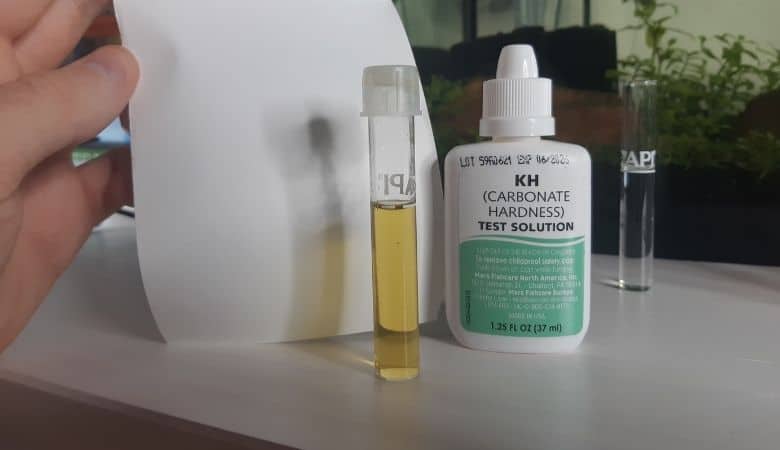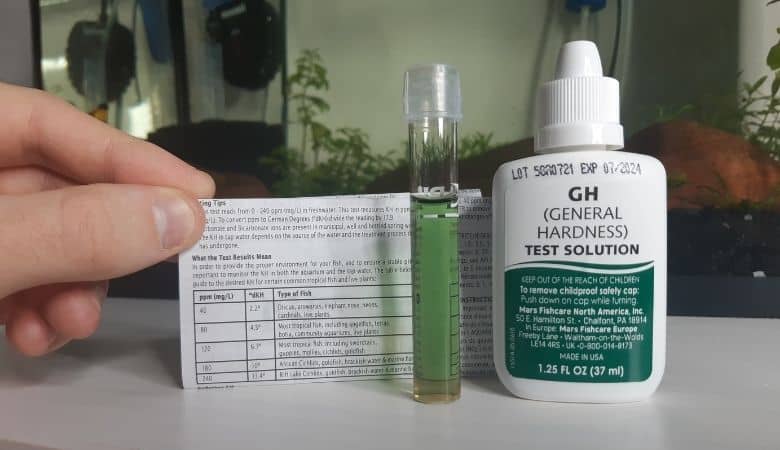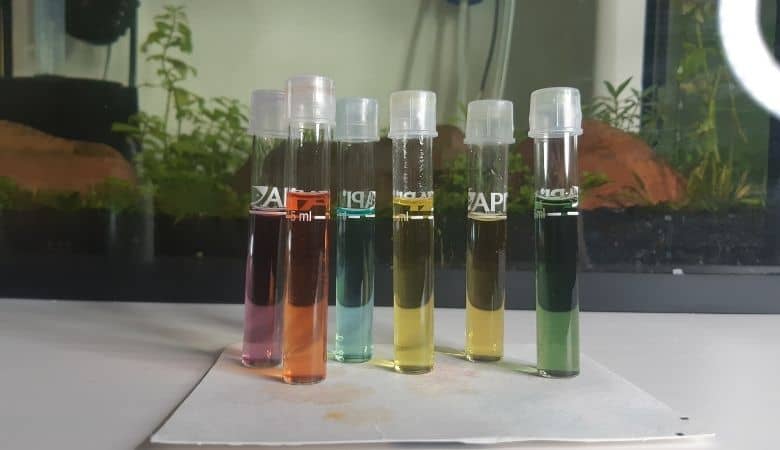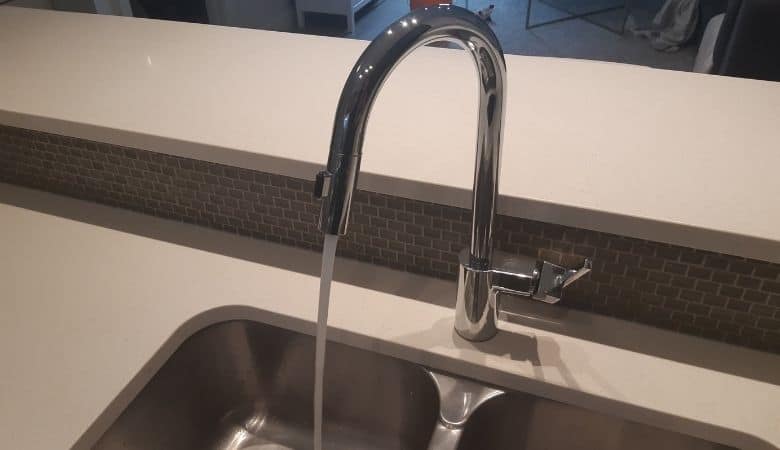Water hardness is a number that represents the mineral content in your water. The higher the number, the harder your water is. Hardness can be confusing to understand at first, but it’s actually pretty simple! This guide will explain everything you need to know about hardness and how it affects planted aquariums.
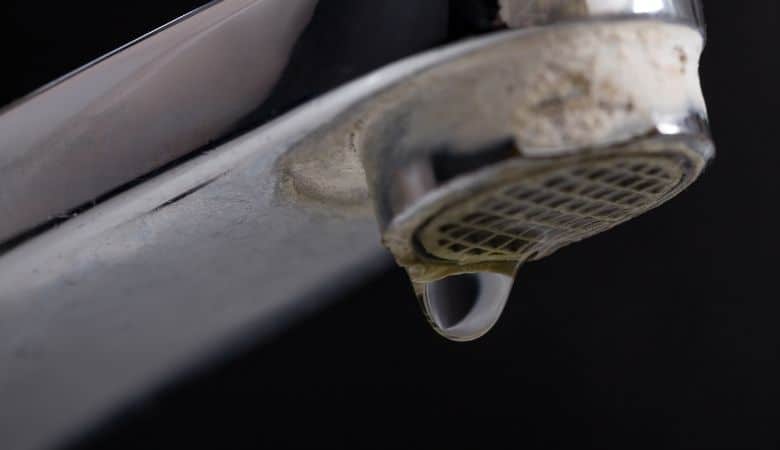
Contents
- 1 What is water hardness?
- 2 What is water hardness measured in?
- 3 What is general hardness (GH)?
- 4 Why is GH important?
- 5 What is carbonate hardness (KH)?
- 6 Why is KH important?
- 7 Is hard water bad for aquarium plants?
- 8 The relationship between KH and pH
- 9 What is an ideal hardness for a planted aquarium?
- 10 What is aquarium alkalinity?
- 11 The difference between alkaline and alkalinity
- 12 How to test water hardness
- 13 Testing for GH
- 14 Testing for KH
- 15 How to increase water hardness
What is water hardness?
“Hard water” generally means a water source has a pH greater than 7.0 and above-average concentrations of calcium, magnesium, carbonate and bicarbonate ions.
These water parameters make it difficult for many freshwater aquatic plants and fish to thrive for several reasons which we’ll discuss.
Within the “water hardness” umbrella, there are two main types of hardness that are important to fishkeepers: 1) general hardness (GH), and 2) carbonate hardness (KH).
What is water hardness measured in?
Water hardness is measured in either parts-per-million (ppm), milligrams per liter (mg/L) or degrees of hardness (dGH or dKH).
Parts-per-million and milligrams per liter are equivalent to each other.
These two measurement scales are much more precise than degrees of hardness, but also requires more advanced titration equipment to measure is accurately. This is usually done in a lab.
On the other hand, degrees of hardness can be measured easily using a liquid drop test that can be purchases online or at most local fish stores.
All of these tests measure the concentration of specific ions in aquarium water, which can then be used to make decisions such as which plants and fish species to keep.
What is general hardness (GH)?
General hardness, or GH, measures the concentration of calcium and magnesium ions in your aquarium water. These ions are often absorbed from limestone and other rocks where the water is originally sourced from.
Many cities with hard water source their water from rivers that contain these rocks. other cities source water from lakes and ponds, which do not contain these same materials.
This means that your local tap water will contain varying amounts of hardness and pH depending on where you live.
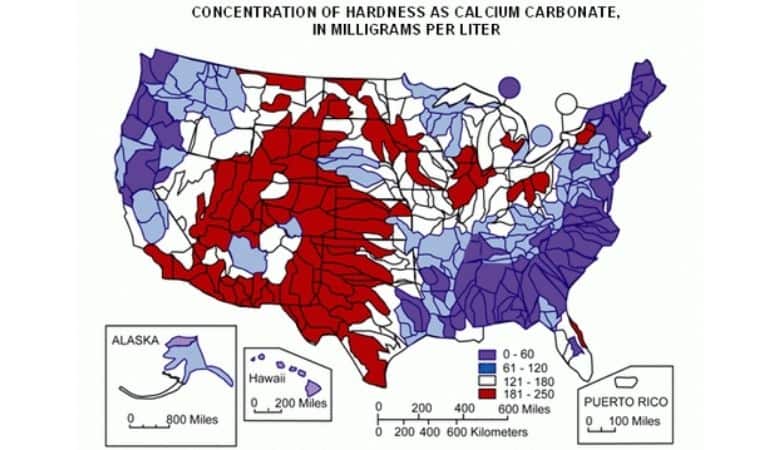
Why is GH important?
Calcium and magnesium ions help fish with osmoregulation and metabolism. But each fish species requires these ions in varying quantities.
For example, African cichlids, mollies, guppies, platies and other livebearers prefer harder water in the 8 dGH or higher range. While other species, such as angelfish and tetras, prefer soft water with a lower GH.
What is carbonate hardness (KH)?
Carbonate hardness, or KH, is the concentration of carbonates and bicarbonates in your water.
Carbonates and bicarbonates release and absorb excess H+ and OH- ions in water. If you remember from before, these H+ and OH- ions are what determines your water’s pH level.
Why is KH important?
Having some degree of carbonate hardness in your water will allow is to resist potential pH fluctuations as long as you have some available carbonate hardness to “soak it up.”
pH fluctuations are harmful for both plants and fish, which makes KH an important water parameter for every aquarium to keep an eye on.
Is hard water bad for aquarium plants?
Hard water itself is not harmful to aquarium plants. In other words, the calcium, magnesium, carbonate and bicarbonate ions that cause water to be “hard” do not adversely affect plants.
However, the concentration of carbonate and bicarbonate ions do have a relationship with the water’s pH level, which is crucially important for maintaining healthy plant life.
The relationship between KH and pH
pH measures the concentration of hydrogen ions (H+) and hydroxyl ions (OH-) in water. A higher concentration of H+ means the water is acidic and has a lower pH. More OH- means the pH is higher.
There are many things that cause these ions to fluctuate, such as decaying plants, fish waste, excess CO2 and more.
In perfectly distilled water with 7.0 pH, 0 dKH and 0 dGH, the pH would consequently fluctuate up and down as these changes occur.
However, if your aquarium has some carbonate or bicarbonate ions (KH), then these pH fluctuations will not occur. This is because your water’s KH acts as a buffer to prevent these swings.
These pH swings are especially harmful for fish because it causes stress. The pH swings also affect aquatic plants as well.
Therefore, it’s important for every aquarium to have some carbonate hardness (KH) to resist these harmful pH swings.
What is an ideal hardness for a planted aquarium?
3-15 dGH, or 54-268 ppm, is a good range for most freshwater fish species. However, some species require more GH than others, such as livebearers and African Cichlids.
Fish are quite adaptable but it’s generally accepted that consistent water parameters are more important than adjusting parameters to meet an “ideal” target.
4-13 dKH, or 72-232 ppm, is a good range to keep your carbonate hardness. Fish and plants are not sensitive to your KKH concentration. But it’s important to maintain some level of KH to buffer against pH swings.
What is aquarium alkalinity?
Alkalinity refers to your water’s ability to resist pH fluctuations. So you might be wondering, “isn’t that what you said KH was?”
In short, yes.
The terms “alkalinity” and “carbonate hardness” often cause confusion among aquarists because they are used interchangeably.
The truth is that “carbonate hardness” only measures your aquarium’s buffering capacity from carbonates and bicarbonates, which are the primary components of the buffering system.
“Alkalinity” is your aquarium’s total buffering capacity, which includes carbonates, bicarbonates and other anions, such as hydroxide, borates, silicates, and phosphates.
The difference between alkaline and alkalinity
The term “alkaline” refers to a solution that has a pH above 7.0. Similar to how a pH below 7.0 is considered “acidic.”
More specifically, this means the solution has a higher concentration of hydroxyl ions (OH-) than hydrogen ions (H+).
The term “alkalinity” refers to a solution’s ability to resist pH swings. This is due to the solution having carbonate and bicarbonate ions that absorb excess hydrogen ions that would otherwise cause a solution’s pH to decrease.
Both terms are related to pH, but they measure completely different things. You will likely come across the term “alkalinity” more frequently in the fishkeeping hobby.
When discussing “alkaline” aquariums, aquarists usually refer to the specific pH value instead of the term “alkaline” because it’s a more precise method of measurement. And it’s usually more useful to understand a specific pH value than it is to understand if it’s generally acidic or alkaline.
How to test water hardness
The most popular liquid test kit for water hardness is the API KH and GH test kit, but there are other brands available that work just as well.
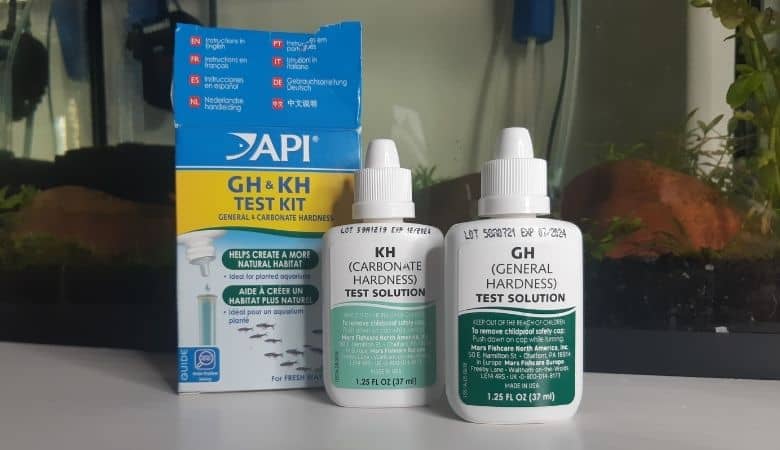
I’ve had success using API’s testing strips as well. These test for nitrite, nitrate, pH, GH and KH. There are also many other testing strip brands that can be purchased from your local fish store, water treatment store or online.
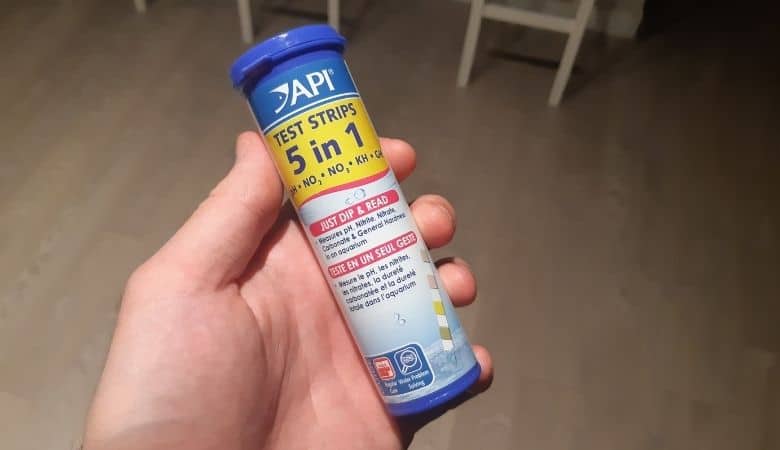
Testing for GH
The API GH liquid test kit requires you to fill a 5ml glass vial with a water sample from your aquarium.
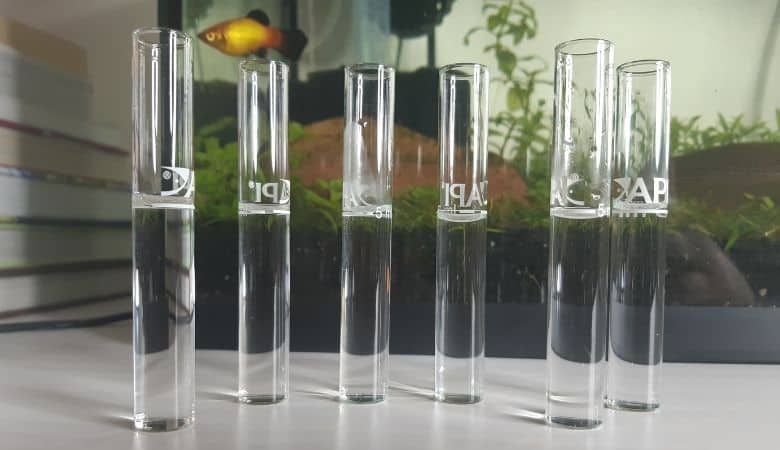
You then add one drop, cap the vial, invert several times and see what color the water turns. At first, the water will turn an orange-red color. This means the test is incomplete.
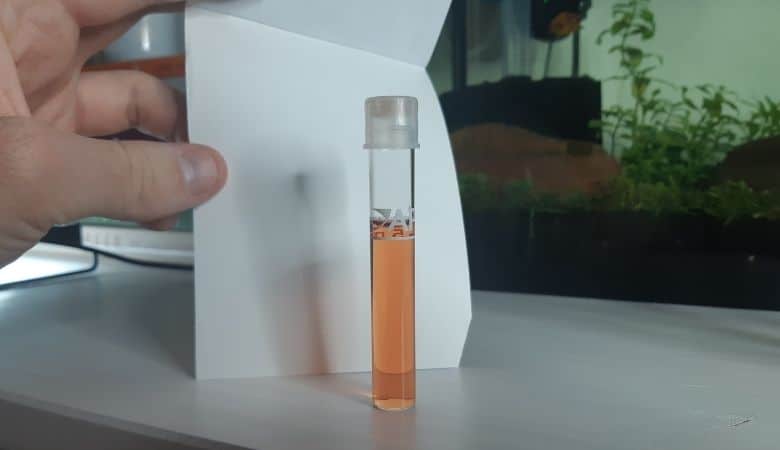
You then take the cap off, add another drop of the GH solution, recap and invert several times. You continue adding one drop at a time and inverting until the solution turns to a green color.
At one point, after adding an additional drop, the color will shift from orange-red to a dark green.
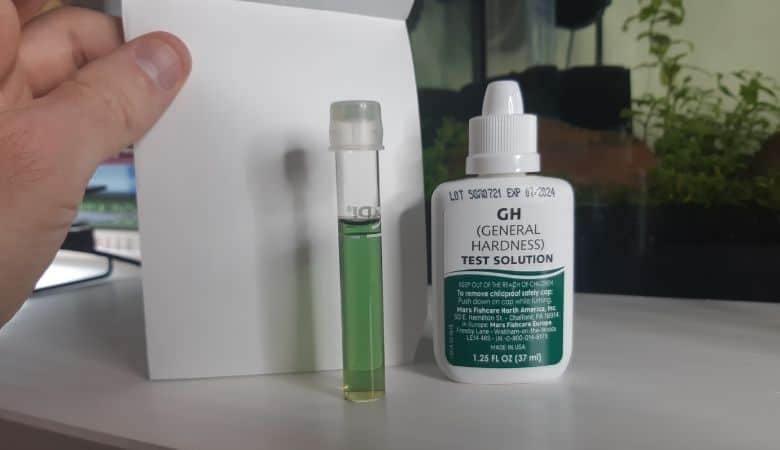
The number of drops required to turn the water green is your degrees of general hardness, or dGH. You can then compare your dGH against the chart below to learn your general hardness in ppm or mg/L.
| dGH or dKH value | GH or KH parts-per-million (ppm) |
| 1 | 17.9 |
| 2 | 35.8 |
| 3 | 53.7 |
| 4 | 71.6 |
| 5 | 89.5 |
| 6 | 107.4 |
| 7 | 125.3 |
| 8 | 143.2 |
| 9 | 161.1 |
| 10 | 179.0 |
| 11 | 196.9 |
| 12 | 214.8 |
Alternatively, you can simply multiple your dGH by 17.86 to get your GH in ppm or mg/L. This number may be off by a few hundreds of a ppm, but it will still be very accurate.
For example, a dGH of 15 x 17.86 = would be a GH of 267.9 ppm.
Testing for KH
KH is tested using the same method as GH, except it uses a different testing solution.
With the KH test, your water sample will start as a blue color. Once you add your final drop to complete the test, the solution will turn into a bright yellow color.
Sometimes adding one drop will cause the solution to change from blue to a light blue-green color. This test is still incomplete and likely only requires another drop to change it to yellow.
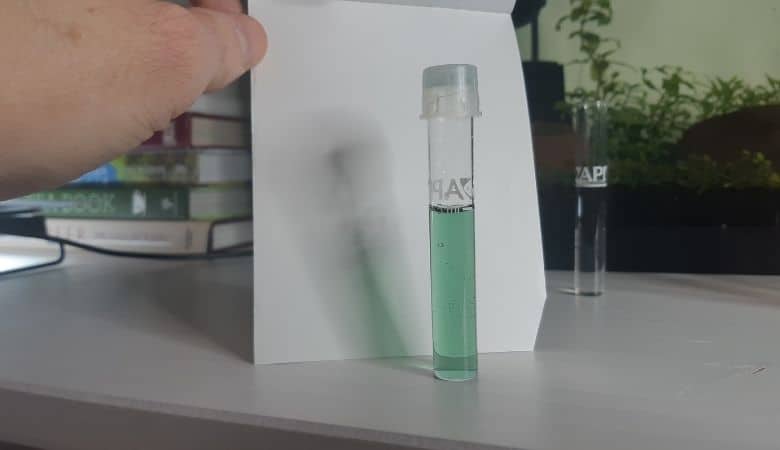
Continue adding drops until your KH test turns into an obvious yellow color.
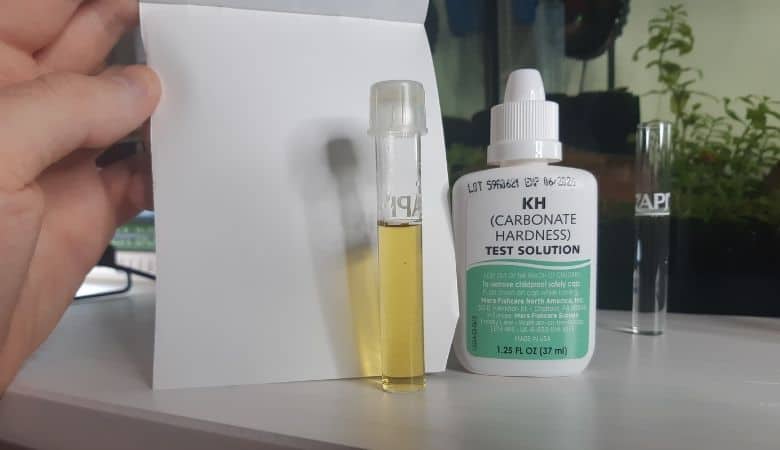
The same math is used to convert dKH to KH as it is to convert dGH to GH. Refer to the conversion chart in the previous GH section to see what your KH would be in ppm or mg/L.
How to increase water hardness
Add crushed coral
The most natural method for increasing general hardness is by adding crushed coral into your aquarium.
You can directly add it as substrate directly into your tank. Or you could place it in a media bag and let it soak in your aquarium water.
This will cause your water hardness to change slowly over the course of a few days or weeks. I recommend using this method with caution because fluctuating water parameters can cause fish stress and disease.
Instead, I recommend adjusting your water chemistry prior to adding livestock.
If it is necessary to increase your water hardness – like it may be if you’re keeping fish such as livebearers or African cichlids – I suggest adjusting your parameters very slowly so your fish can successfully acclimate to the changes.
Use RO water
The most precise method for lowering your water hardness is by using a reverse-osmosis system.
These systems are designed to filter out virtually all water impurities. The result is clean water with 7.0 pH and 0 KH and 0 GH.
Now, water with zero hardness is actually not a good thing. You will require some general hardness depending on the fish you keep. And you will require some carbonate hardness to buffer against pH swings.
Therefore, you would need to remineralize your RO water with something like Seachem Equilibrium, Acid Buffer and Alkaline Buffer.
This method will allow you to achieve your desired pH and water hardness, but it also require an expensive RO filtration system and remineralization products.


